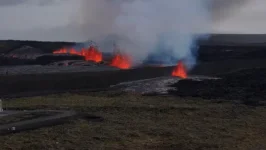People ran from their homes as a volcano blew up in Iceland yesterday, forcing everyone to leave a nearby town and a popular spa. The ground split open more than a mile long, with hot lava and smoke shooting into the sky. The bright orange fire made quite a show against the dark landscape.
The earth shook many times during the day around the volcano area. Officials worried about the small fishing town called Grindavik and the Blue Lagoon, which tourists love to visit. Most people left when asked, but news reports said a few stubborn residents stayed behind in about eight houses.
Police told everyone to move away from danger zones. Scientists warned that lava might flow right into parts where people live. A hot water pipe broke in the north part of Grindavik, showing that the ground underneath had cracked badly. The protective walls built around the town failed when a new crack opened up inside them.
Roads were closed all around Grindavik, but planes still flew as normal. Most of the 4,000 people who lived there had already moved out during a big evacuation back in 2023 because of similar dangers. This volcano has erupted several times since then.
Scientists measured the magma that formed Tuesday at almost seven miles long - the biggest stretch they've seen since November 2023. The underground magma path extends three miles farther than previous eruptions. Wind patterns suggest gas from the volcano will blow northeast toward the capital city.
The eruption started around 9:45 in the morning, after several earthquakes hit the area known as the Sundhnúk crater range. The Reykjanes Peninsula has seen many eruptions since 2021. Before that, this region stayed quiet for 800 years - but history shows these active periods can last for decades once they start.
Iceland has 33 active volcano systems sitting right on top of where two giant tectonic plates meet under the Atlantic Ocean. This position explains why the country experiences frequent volcanic activity compared to most places on Earth.
The earth shook many times during the day around the volcano area. Officials worried about the small fishing town called Grindavik and the Blue Lagoon, which tourists love to visit. Most people left when asked, but news reports said a few stubborn residents stayed behind in about eight houses.
Police told everyone to move away from danger zones. Scientists warned that lava might flow right into parts where people live. A hot water pipe broke in the north part of Grindavik, showing that the ground underneath had cracked badly. The protective walls built around the town failed when a new crack opened up inside them.
Roads were closed all around Grindavik, but planes still flew as normal. Most of the 4,000 people who lived there had already moved out during a big evacuation back in 2023 because of similar dangers. This volcano has erupted several times since then.
Scientists measured the magma that formed Tuesday at almost seven miles long - the biggest stretch they've seen since November 2023. The underground magma path extends three miles farther than previous eruptions. Wind patterns suggest gas from the volcano will blow northeast toward the capital city.
The eruption started around 9:45 in the morning, after several earthquakes hit the area known as the Sundhnúk crater range. The Reykjanes Peninsula has seen many eruptions since 2021. Before that, this region stayed quiet for 800 years - but history shows these active periods can last for decades once they start.
Iceland has 33 active volcano systems sitting right on top of where two giant tectonic plates meet under the Atlantic Ocean. This position explains why the country experiences frequent volcanic activity compared to most places on Earth.












